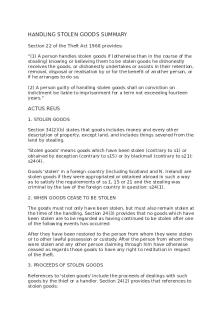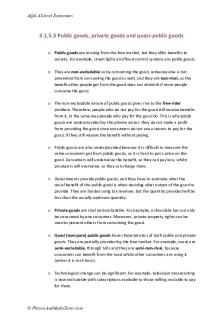Grave Goods- Egyptian Amulets PDF

| Title | Grave Goods- Egyptian Amulets |
|---|---|
| Course | Introduction to the Ancient World |
| Institution | Canterbury Christ Church University |
| Pages | 3 |
| File Size | 232.6 KB |
| File Type | |
| Total Downloads | 3 |
| Total Views | 152 |
Summary
A summary of the use and purpose of amulets in Ancient Egypt, with a few famous examples. ...
Description
Amulets in Ancient Egypt Egyptian amulets were worn by both the living and the dead. Amulets had several different uses. Some were intended to protect the wearer against specific dangers, whilst others endowed him or her with special characteristics. Amulets were often in the shape of animals, plants, sacred objects, or hieroglyphic symbols. The combination of shape, colour and material were important to the effectiveness of an amulet. Papyri show that amulets were used in medicine, often in conjunction with poultices (a medicated dressing, often applied hot) or other preparations, and the recitation of spells. Sometimes, the papyri on which the spells were written could also act as amulets, and were folded up and worn by the owner. One of the most widely worn protective amulets was the wedjat eye: the restored eye of Horus. It was worn by the living, and often appeared on rings and as an element of necklaces. It was also placed on the body of the deceased during the mummification process to protect the incision through which the internal organs were removed. Several of the spells in the Book of the Dead were intended to be spoken over specific amulets, which were then placed in particular places on the body of the deceased. The scarab was an important funerary amulet, associated with rebirth, and the heart scarab amulet prevented the heart from speaking out against the deceased.
Amulets used in Mummification (Funerary amulets) When a body is mummified, the arms and legs are wrapped separately. Between the layers of wrapping, the embalmers place amulets to protect the body in its journey through the underworld. The Heart-Scarab (Beetle) – Used from late middle kingdom until Roman times. Within the Book of the Dead, the text of Spell 30b, the objective of the heart scarab was to prevent “the heart from giving evidence against the deceased in the Judgment before Osiri..” Usually found over the heart. The Two Fingers- described as “the two fingers of Horus which the latter extended to his father Osiris, in order to assist him to mount to the top of the heavenly ladder”.This belief was not translated from the Book of the Dead, but from the Pyramid Text, the oldest found hieroglyphs of spells. The amulet was usually found on the left side of the pelvis where the first incision was made. The Name-bead-The amulet was usually just worn around the throat of the mummy, with the name of the deceased. It was in the shape of a barrel or flattened bead and made out of carnelian, The Serpent-head amulet- This amulet is a representation the uraeus, a figure of the scared serpent, worn by the Sun-god, to help protect the dead from the dangerous serpents of the Underworld. The belief was the deceased laying in the tomb could possibly be bitten in the throat, so the amulet could protect the deceased.” The amulet was found at the neck of the deceased along with the name-bead. The Golden Falcon-head Collar- This amulet is a miniature collar with two falcon heads and appears in the Late Period (664-332 BC, under Saite ruler Psamtek I[13]). This amulet actually is a descendant of “the large full-sized falcon-collars depicted in the MiddleKingdom coffin paintings” and the one that was found on the actual mummy of Tutankhamun. The purpose for this amulet was to help free the deceased by Osiris, Isis and Horus from their “mummy-wrappings so that he may live once more.”
Sources http://www.ancientegypt.co.uk/mummies/story/page9.html http://www.britishmuseum.org/explore/highlights/articles/e/egyptian_amulets.aspx http://www.metmuseum.org/toah/hd/egam/hd_egam.htm#slideshow16 http://myweb.usf.edu/~liottan/funeryamulets.html
Aegis of Sekhmet or Bastet, Third Intermediate Period and later (ca. 1070–332 b.c.) Egyptian Faience Gift of Helen Miller Gould, 1910
Head of a cobra, Dynasty 12–13 (ca. 1981–1640 b.c.) Egyptian; Lisht North Carnelian Rogers Fund, 1909
Fish, Dynasty 12–13 (ca. 1981–1640 b.c.) Egyptian; Lisht North, Tomb L847 Gold, beryl Rogers Fund, 1909
Hippo's head, Dynasty 12 (ca. 1981– 1802 b.c.) Egyptian Beryl Gift of Helen Miller Gould, 1910
Hand and foot amulets, Dynasty 5–8 (ca. 2465–2100 b.c.) Egyptian Carnelian Gift of Helen Miller Gould, 1910
Hedgehog amulet on a string, Dynasty 12 (ca. 1981–1802 b.c.) Egyptian; Lisht North, Pit 995 Glazed steatite, reed Rogers Fund, 1922 Elephant, Late Naqada II (ca. 3650–3300 b.c.) Egyptian Serpentine, bone Rogers Fund, 1959
Wedjet eye, Ptolemaic Period (ca. 304–30 b.c.) Egyptian Gold Rogers Fund, 1923
Tyet sign, early Dynasty 18 (ca. 1550– 1458 b.c.) Egyptian; Abydos Jasper Gift of Egypt Exploration Fund, 1900
Egyptian Amulets discoveriescurrently exhibited in the Metropolitan Museum of Art...
Similar Free PDFs

Grave Goods- Egyptian Amulets
- 3 Pages

Miedo Grave-EJEMPLO
- 2 Pages

Marquez- Algo muy grave.
- 2 Pages

Ancient Egyptian Bull Worship
- 4 Pages

03-HOA Ancient Egyptian
- 9 Pages

Cradle to the Grave week 1
- 5 Pages

Handling stolen goods
- 3 Pages

Sell Goods Okkkk
- 7 Pages

Sales of Goods Act
- 7 Pages

Dangerous Goods 100 questions
- 6 Pages

Trespass to goods notes
- 4 Pages
Popular Institutions
- Tinajero National High School - Annex
- Politeknik Caltex Riau
- Yokohama City University
- SGT University
- University of Al-Qadisiyah
- Divine Word College of Vigan
- Techniek College Rotterdam
- Universidade de Santiago
- Universiti Teknologi MARA Cawangan Johor Kampus Pasir Gudang
- Poltekkes Kemenkes Yogyakarta
- Baguio City National High School
- Colegio san marcos
- preparatoria uno
- Centro de Bachillerato Tecnológico Industrial y de Servicios No. 107
- Dalian Maritime University
- Quang Trung Secondary School
- Colegio Tecnológico en Informática
- Corporación Regional de Educación Superior
- Grupo CEDVA
- Dar Al Uloom University
- Centro de Estudios Preuniversitarios de la Universidad Nacional de Ingeniería
- 上智大学
- Aakash International School, Nuna Majara
- San Felipe Neri Catholic School
- Kang Chiao International School - New Taipei City
- Misamis Occidental National High School
- Institución Educativa Escuela Normal Juan Ladrilleros
- Kolehiyo ng Pantukan
- Batanes State College
- Instituto Continental
- Sekolah Menengah Kejuruan Kesehatan Kaltara (Tarakan)
- Colegio de La Inmaculada Concepcion - Cebu




